Ismail M., Koelink E. (editors) Theory and Applications of Special Functions
Подождите немного. Документ загружается.

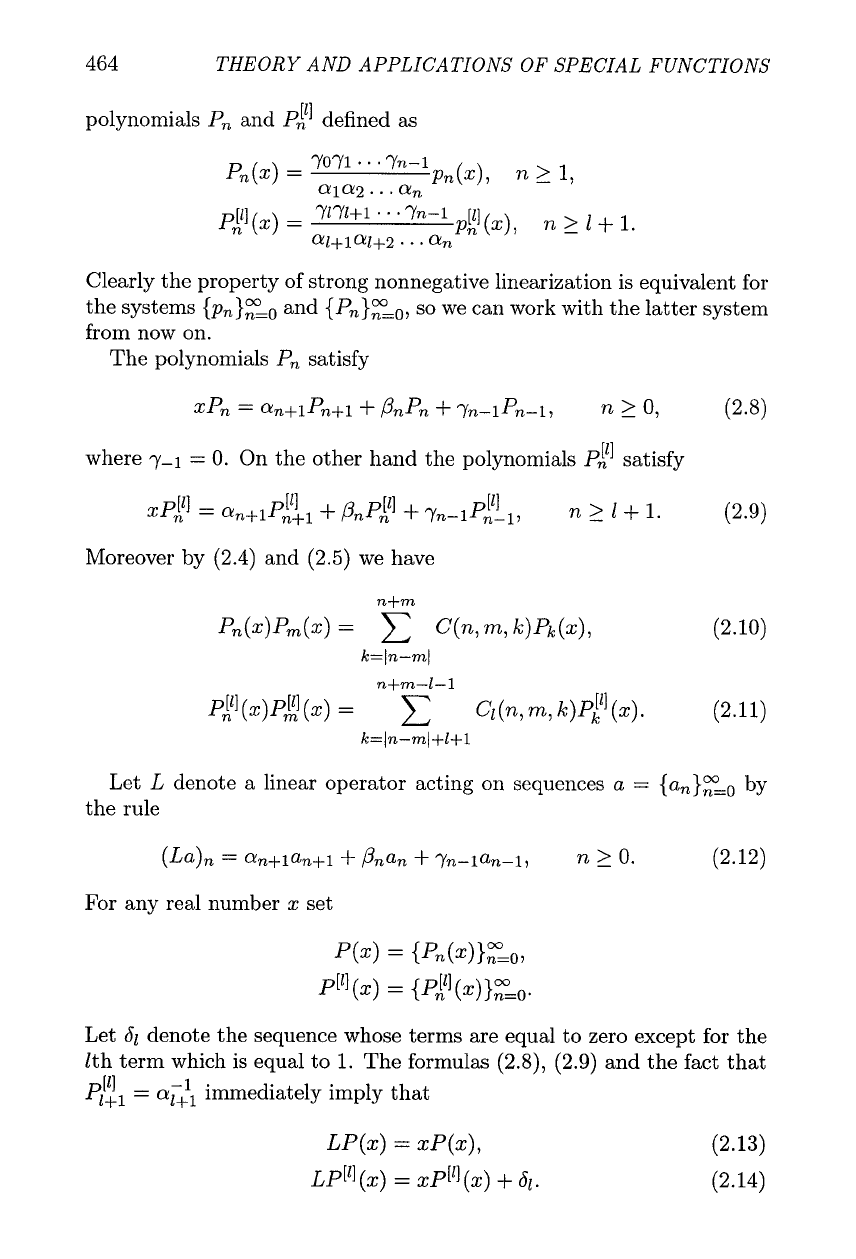
464
THEORY AND APPLICATIONS OF SPECIAL FUNCTIONS
polynomials
Pn
and
P!
defined
as
Clearly the property of strong nonnegative linearization is equivalent for
the systems
{pn)r=o
and
{Pn),",o,
so we can work with the latter system
from now on.
The polynomials
Pn
satisfy
[11
where
7-1
=
0.
On the other hand the polynomials
Pn
satisfy
Moreover by
(2.4)
and
(2.5)
we have
Let
L
denote a linear operator acting on sequences
a
=
{an)r=O
by
the rule
For any real number
x
set
Let
61
denote the sequence whose terms are equal to zero except for the
lth term which is equal to
1.
The formulas
(2.8), (2.9)
and the fact that
PI
-
-
1
Pl+l
-
al+l
immediately imply that
LP(x)
=
xP(x), (2.13)
LP[~]
(x)
=
ZP["
(x)
+
61.
(2.14)
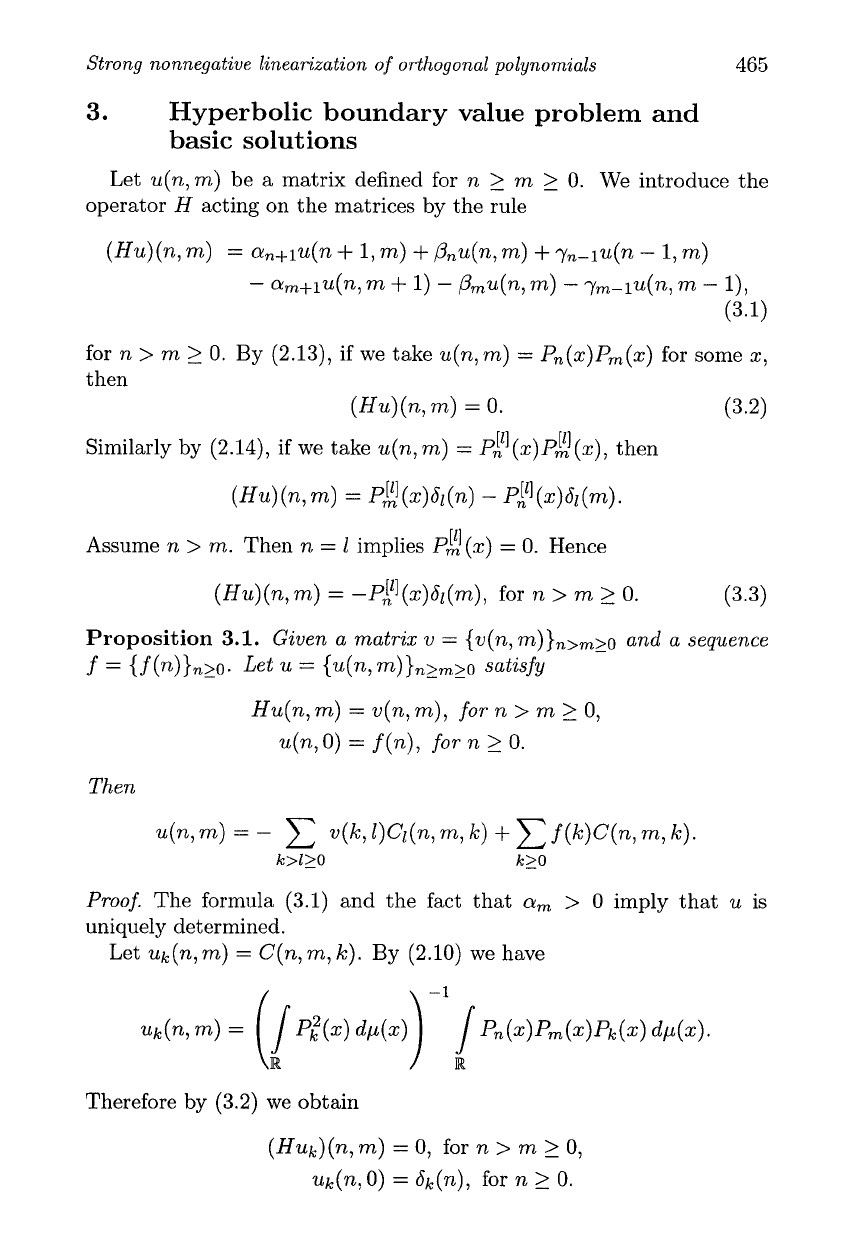
Strong nonnegative linearization
of
orthogonal polynomials
465
3.
Hyperbolic boundary value problem and
basic solutions
Let
u(n,m)
be a matrix defined for
n
>
m
>
0.
We introduce the
operator
H
acting on the matrices by the rule
for
n
>
m
>
0.
By
(2.13),
if we take
u(n,m)
=
Pn(x)Pm(x)
for some
x,
then
(Hu)(n,
m)
=
0.
(3.2)
Similarly by
(2.14),
if we take
u(n,
m)
=
P;']
(x)P;
(x),
then
['I
Assume
n
>
m.
Then
n
=
I
implies
Pm (x)
=
0.
Hence
(Hu)(n,m)
=
-~~'](x)d~(m),
for
n
>
m
2
0.
(3.3)
Proposition
3.1.
Given a matrix v
=
{v(n, m))n>m>o
-
and a sequence
f
=
{f (n))n>o. Let u
=
{~(n,
m))n>m>o satisfy
Hu(n,
m)
=
v(n,
m),
for
n
>
m
>
0,
u(n,O)
=
f(n),
forn
>
0.
Then
Proof.
The formula
(3.1)
and the fact that
am
>
0
imply that
u
is
uniquely determined.
Let
uk(n,
m)
=
C(n,
m,
k).
By
(2.10)
we have
Therefore by
(3.2)
we obtain
(Huk)(n,
m)
=
0,
for
n
>
m
>
0,
uk(n, 0)
=
dk(n),
for
n
2
0.
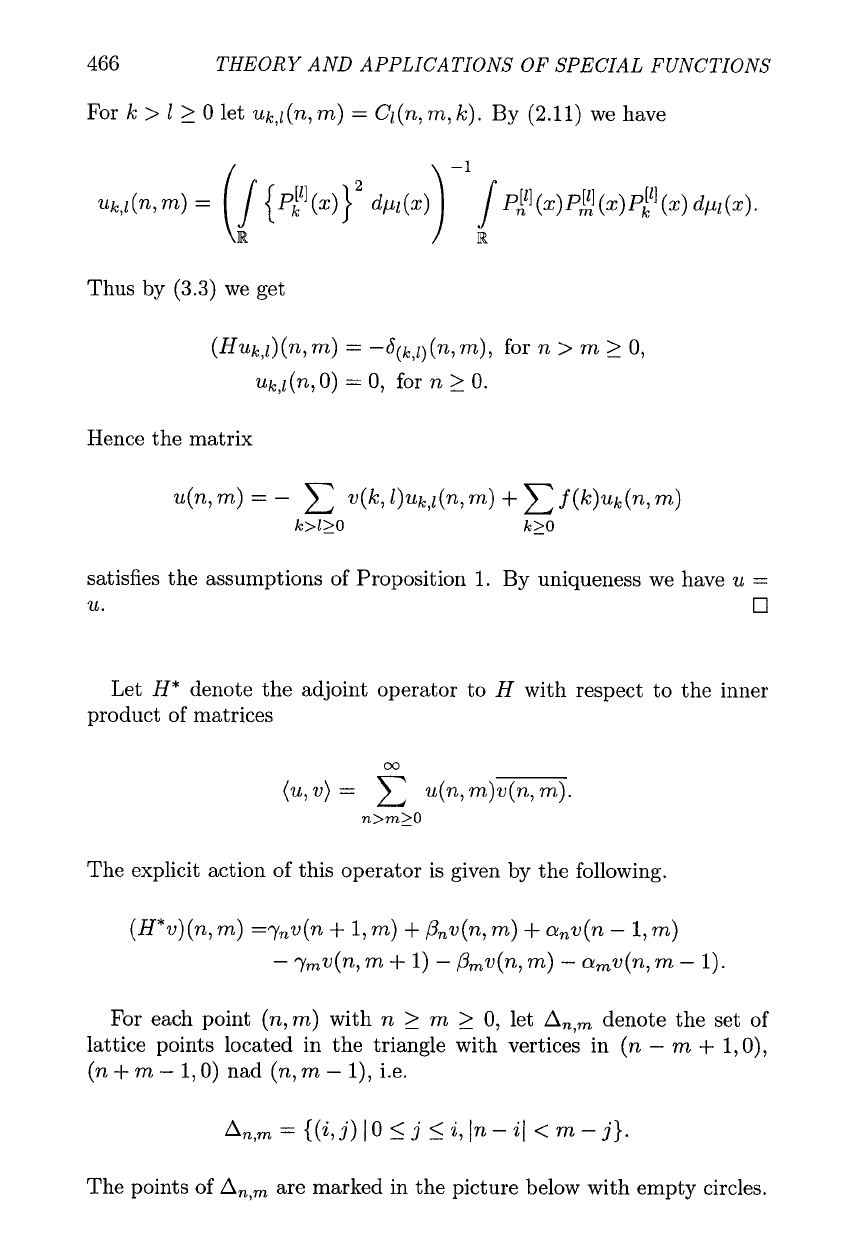
466
THEORY AND APPLICATIONS OF SPECIAL FUNCTIONS
For
k
>
1
>
0
let
~k,~(n,
m)
=
Cl(n,m, k).
By
(2.11)
we have
Thus by
(3.3)
we get
Hence the matrix
satisfies the assumptions of Proposition
1.
By uniqueness we have
u
=
u.
0
Let
H*
denote the adjoint operator to
H
with respect to the inner
product of matrices
The explicit action of this operator is given by the following.
For each point
(n,m)
with
n
2
m
>
0,
let
A,,,
denote the set of
lattice points located in the triangle with vertices in
(n
-
m
+
1,0),
(n
+
m
-
1,O)
nad
(n,
m
-
I),
i.e.
A,,,
=
{(i, j)
1
0
5
j
5
i,
In
-
il
<
m
-
j}.
The points of
A,,,
are marked in the picture below with empty circles.
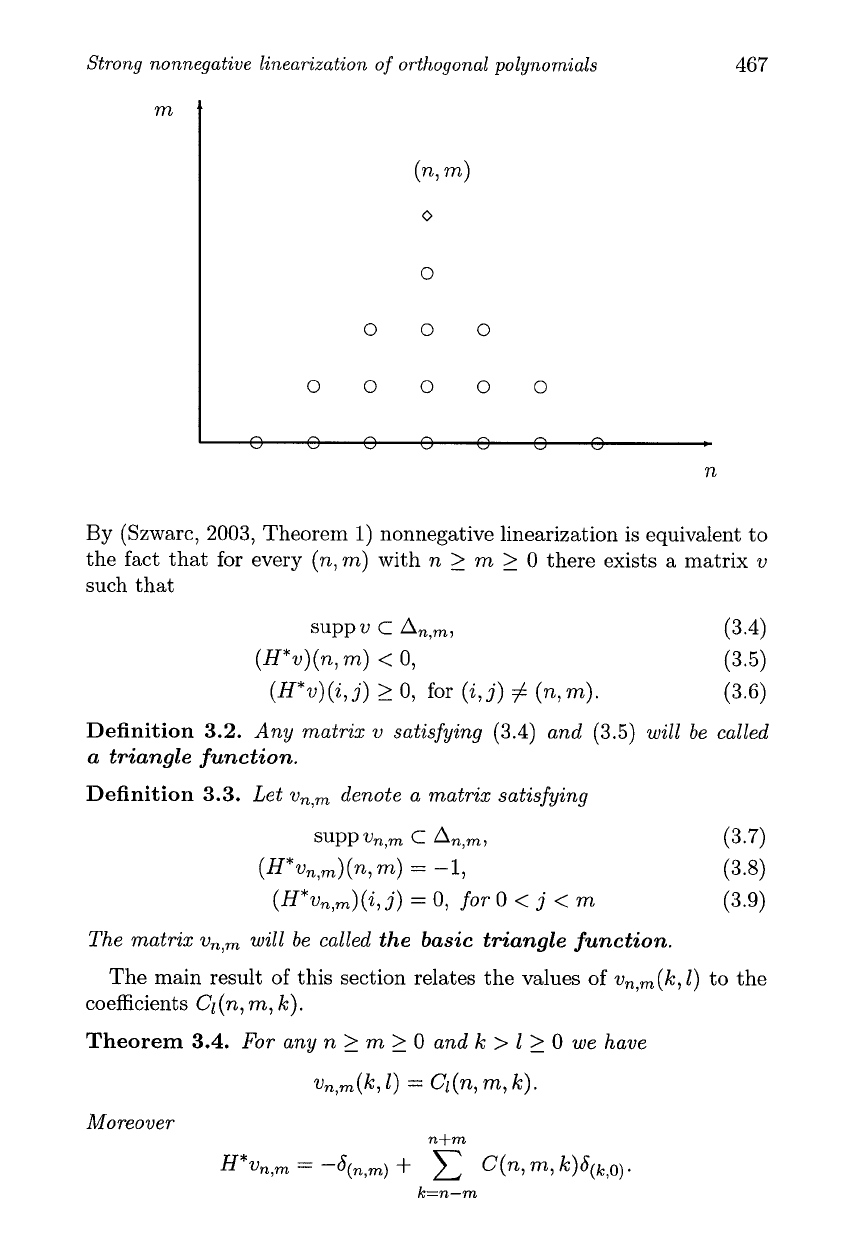
Strong nonnegative linearization of orthogonal polynomials
By
(Szwarc,
2003,
Theorem
1)
nonnegative linearization is equivalent to
the fact that for every
(n,m)
with
n
2
m
>
0
there exists a matrix
v
such that
Definition
3.2.
Any matrix
v
satisfying
(3.4)
and
(3.5)
will be called
a triangle function.
Definition
3.3.
Let
v,,,
denote a matrix satisfying
SUPP
vn,m
c
An,,,
(3.7)
(H*vn,m)(n,
m)
=
-1,
(3.8)
(H*v~,~)(~,
j)
=
0,
for
0
<
j
<
m
(3.9)
The matrix
vn,,
will be called
the basic triangle function.
The main result of this section relates the values of
vn,,(k,
I)
to the
coefficients
Cl
(n,
m,
k)
.
Theorem
3.4.
For any
n
>
m
>
0
and
k
>
1
2
0
we have
Moreover
n+m
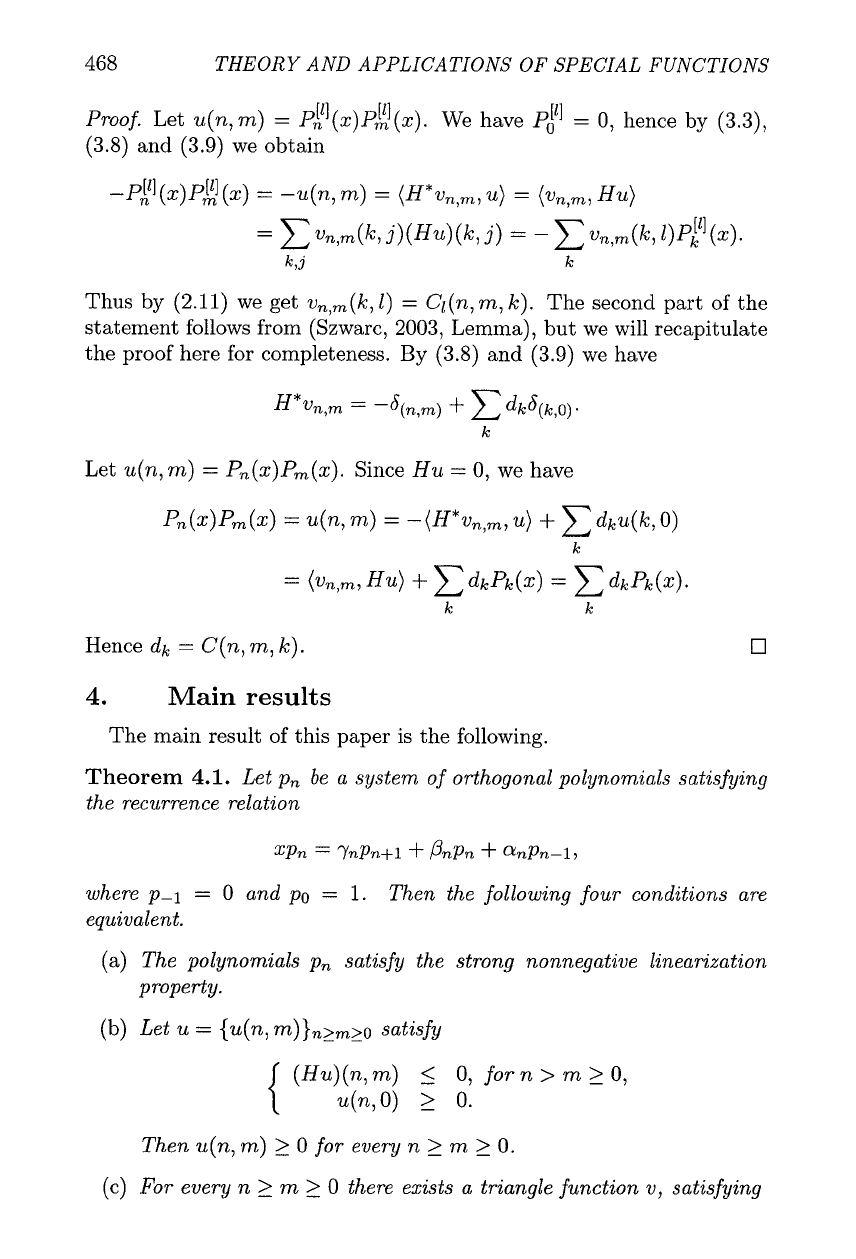
468
THEORY AND APPLICATIONS OF SPECIAL FUNCTIONS
Proof.
Let
u(n,
m)
=
piz1
(x)
P!
(x).
We have
P!]
=
0,
hence by
(3.3),
(3.8)
and
(3.9)
we obtain
Thus by
(2.11)
we get
vn,,(k,I)
=
Cl(n,m,k).
The second part of the
statement follows from (Szwarc,
2003,
Lemma), but we will recapitulate
the proof here for completeness. By
(3.8)
and
(3.9)
we have
Let
u(n,
m)
=
Pn(x) Pm(x).
Since
Hu
=
0,
we have
Hence
dk
=
C
(n,
m,
k)
.
4.
Main
results
The main result of this paper is the following.
Theorem
4.1.
Let
pn
be a system of orthogonal polynomials satisfying
the recurrence relation
where p-1
=
0
and po
=
1.
Then the following four conditions are
equivalent.
(a)
The polynomials pn satisfy the strong nonnegative linearization
property.
(Hu)(n,
m)
I
0,
for
n
>
m
2
0,
{
u(n,O)
2
0.
Then
u(n, m)
2
0
for every
n
2
m
2
0.
(c)
For every
n
2
m
2
0
there exists a triangle function
v,
satisfying
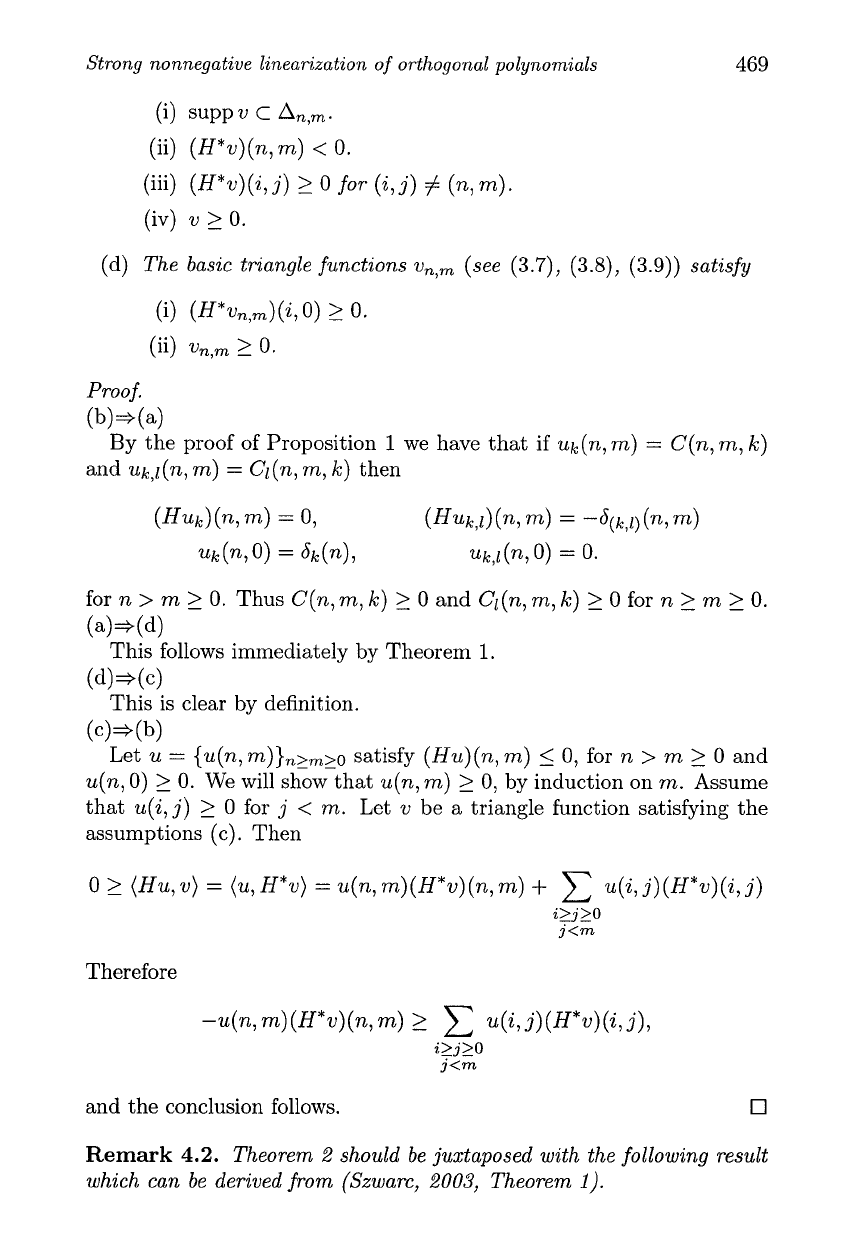
Strong nonnegative linearization of orthogonal polynomials
469
(i) supp v
C
&,m
(ii) (H*v)(n, m)
<
0.
(iii) (H*v)(i,
j)
>
0 for
(i,
j)
#
(n, m).
(iv) v
>
0.
(d) The basic triangle functions vn,, (see
(3.7),
(3.8), (3.9)) satisfy
(i) (H*vn,m)(i, 0)
>
0.
(ii) vn,m
>
0.
Proof.
(b)=w
By the proof of Proposition
1
we have that if uk(n, m)
=
C(n, m, k)
and
U~,J
(n,
m)
=
Cl (n, m, k) then
forn>m>O. ThusC(n,m,k) >OandCl(n,m,k) >Oforn>m>O.
(a)=' (dl
This follows immediately by Theorem
1.
(d)=w
This is clear by definition.
(c)=m
Let u
=
{u(n, m))nym20 satisfy (Hu)(n, m)
5
0,
for n
>
m
>
0 and
u(n, 0)
>
0. We will show that u(n, m)
>
0, by induction on m. Assume
that u(i,
j)
>
0 for
j
<
m. Let v be a triangle function satisfying the
assumptions (c)
.
Then
0
>
(Hu,
V)
=
(u, H*v)
=
u(n, m)(H*v)(n, m)
+
u(i, j)(H*v)(i,
j)
Dj20
j<m
Therefore
and the conclusion follows.
0
Remark
4.2.
Theorem 2 should be juxtaposed with the following result
which can be derived from (Szwarc, 2003, Theorem
1).
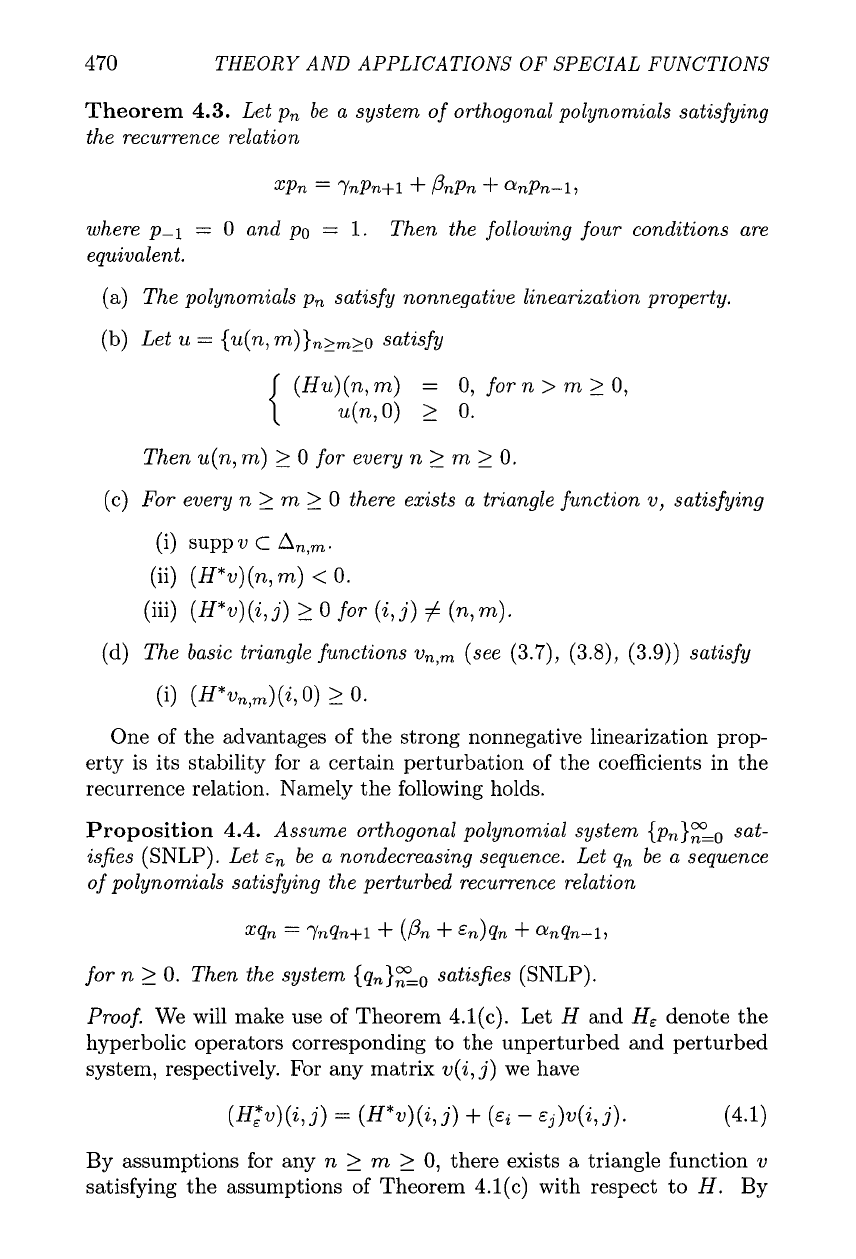
470
THEORY AND APPLICATIONS OF SPECIAL FUNCTIONS
Theorem
4.3.
Let pn be a system of orthogonal polynomials satisfying
the recurrence relation
where p-1
=
0 and po
=
1.
Then the following four conditions are
equivalent.
(a) The polynomials pn satisfy nonnegative linearization property.
(Hu)(n,
m)
=
0, for
n
>
m
2
0,
u(n,O)
2
0.
Then u(n,
m)
>
0 for every
n
>
m
2
0.
(c) For every
n
>
m
>
0 there exists a triangle function v, satisfying
(i)
~UPP
v
C
An,,
.
(ii) (H*v)(n,m)
<
0.
(iii) (H*v)
(i,
j)
>
0 for
(i,
j)
#
(n,
m).
(d) The basic triangle functions vn,, (see (3.7),
(3.8),
(3.9)) satisfy
One of the advantages of the strong nonnegative linearization prop-
erty is its stability for a certain perturbation of the coefficients in the
recurrence relation. Namely the following holds.
Proposition
4.4.
Assume orthogonal polynomial system {P~);.~ sat-
isfies (SNLP). Let
E,
be a nondecreasing sequence. Let qn be a sequence
of polynomials satisfying the perturbed recurrence relation
for
n
>
0.
Then the system {qn)?=o satisfies (SNLP).
Proof. We will make use of Theorem 4.l(c). Let
H
and H, denote the
hyperbolic operators corresponding to the unperturbed and perturbed
system, respectively. For any matrix v(i, j) we have
(H,*v)(i, j)
=
(H*v)(i, j)
+
(Ei
-
Ej)v(i, j).
(4.1)
By assumptions for any
n
>_
m
>
0, there exists a triangle function v
satisfying the assumptions of Theorem 4.l(c) with respect to
H.
By

Strong nonnegative linearization of orthogonal polynomials
471
(4.1) the same matrix v satisfies these assumptions with respect to
HE.
Indeed, the assumptions (i) and (iv) do not depend on the perturbation.
Since v(n, m)
=
0
the assumption (ii) is not affected, as well. Concerning
(iii), since v
2
0
and
E,
is nondecreasing we have
for
i
2
j
2
0
and
j
<
m. Hence the perturbed system of polynomials
satisfies (SNLP)
.
0
5.
Some necessary and sufficient conditions
We begin with the following generalization of Theorem
1
of (Szwarc,
l992a).
Theorem
5.1.
Let orthogonal polynomials {pn}zi0 satisfy (2.1). Let
{c,)~=~ be a fixed sequence of positive numbers with co
=
1
and
Assume that
(ii)
a,
5
a;
for m
<
n.
(iii)
a,
+
y,
5
a;
+
y; for m
<
n.
Then the system {~n)z=~ satisfies the strong nonnegative linearization
property.
Proof. It suffices to construct a suitable triangle function for every (n, m),
with n
>
m, i.e., a matrix v satisfying the assumptions of Theorem
4.1 (c). Fix (n, m). Define the matrix v according to the following.
v(i,j)
=
ci
(i,
j)
E
A,,,,
(n
+
m)
-
(i
+
j) odd
0
otherwise (5.1)
The points in the support of v,,, are marked by empty circles in the
picture below.
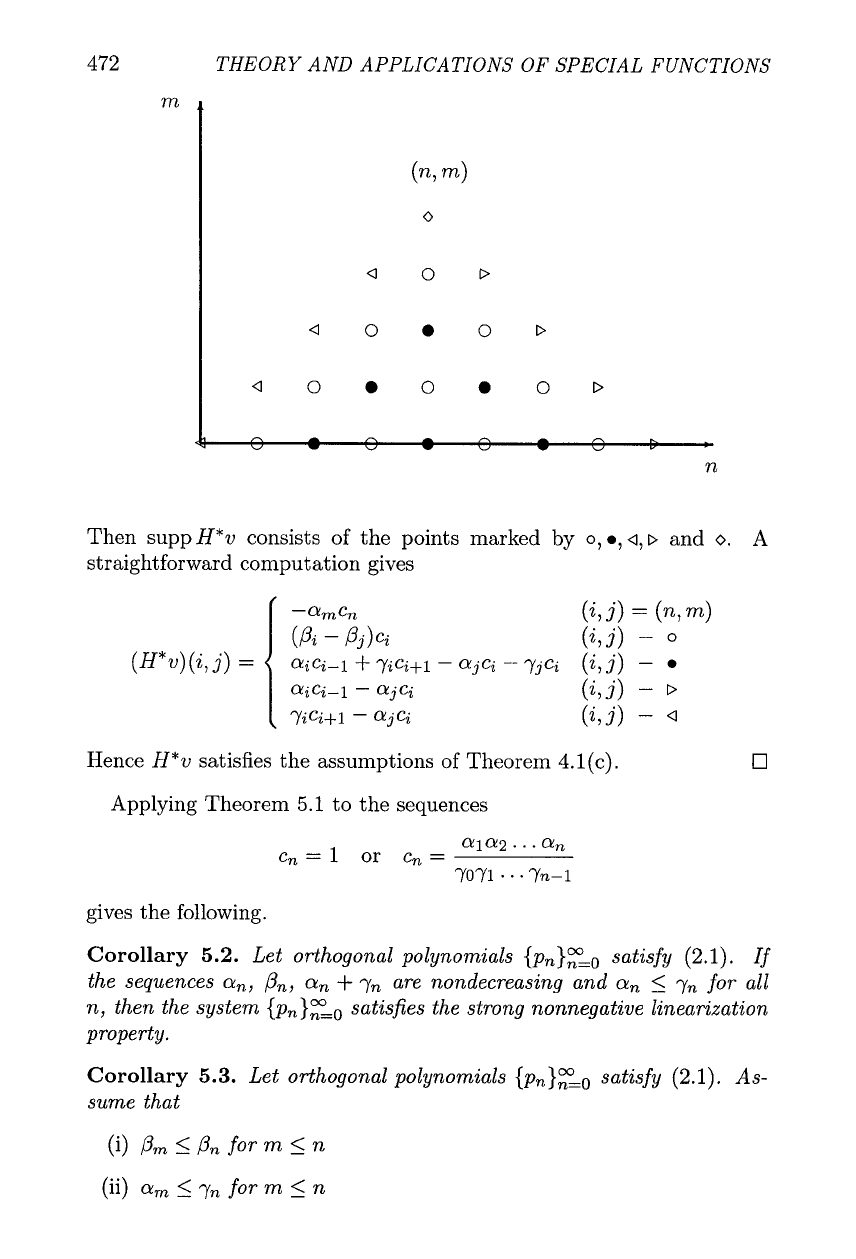
THEORY AND APPLICATIONS OF SPECIAL FUNCTIONS
Then supp
H*v
consists of the points marked
by
o, o,
a,
D and
o.
A
straightforward computation gives
Hence
H*v
satisfies the assumptions of Theorem 4.l(c).
Applying Theorem 5.1 to the sequences
gives the following.
Corollary
5.2.
Let orthogonal polynomials {P~)~!~ satisfy
(2.1).
If
the sequences
a,,
Pn,
a,
+
y, are nondecreasing and
a,
5
y,
for all
n,
then the system {P,):?~ satisfies the strong nonnegative linearization
property.
Corollary
5.3.
Let orthogonal polynomials satisfy
(2.1).
As-
sume that
(ii)
a,
5
y,
for
m
5
n
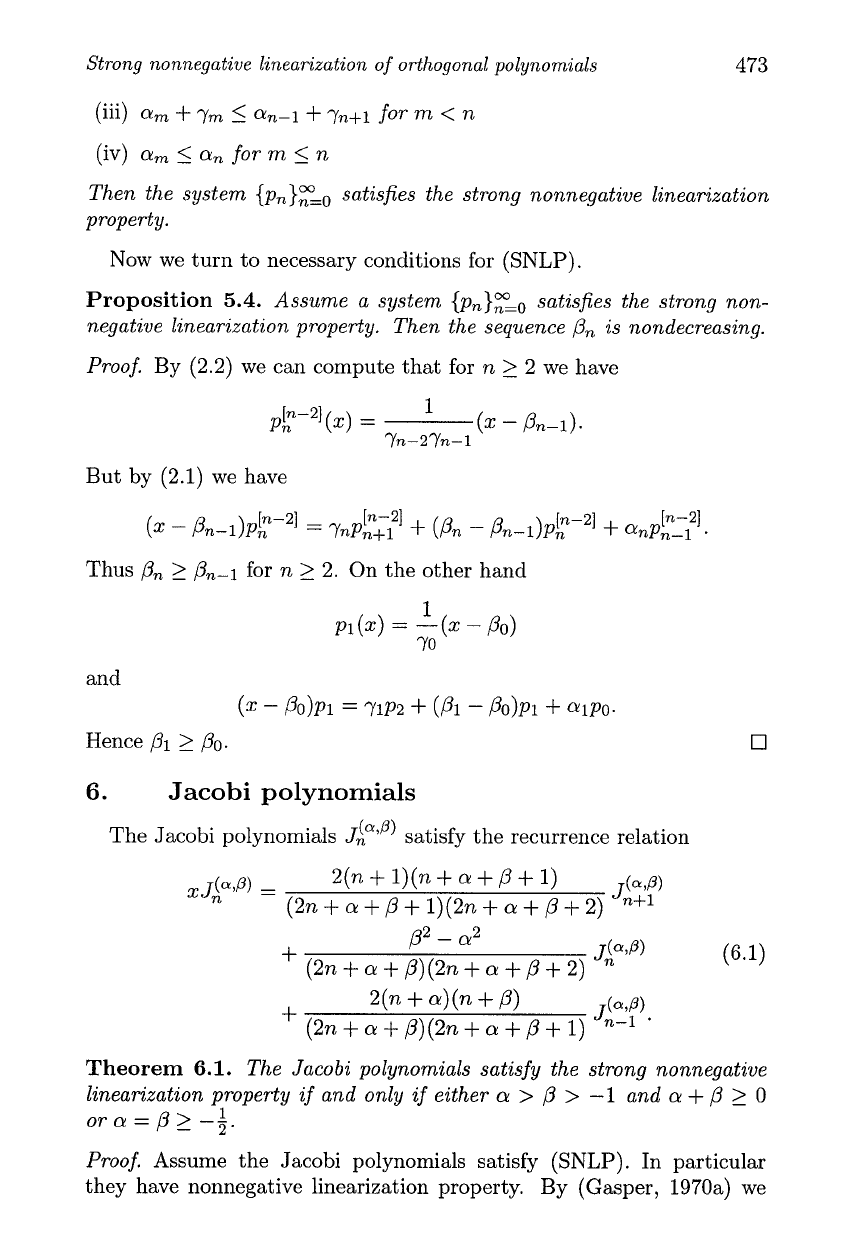
Strong nonnegative linearization of orthogonal polynomials
473
(iii)
am
+
Ym
5
an-1
+
yn+l
for
m
<
n
(iv)
a,
5
an
for
m
5
n
Then the system
{~n)r=~
satisfies the strong nonnegative linearization
property.
Now we turn to necessary conditions for (SNLP).
Proposition
5.4.
Assume a system
{pn)F==O
satisfies the strong non-
negative linearization property. Then the sequence
,On
is nondecreasing.
Proof.
By (2.2) we can compute that for
n
2
2 we have
But by (2.1)
we
have
(X
-
@n-l)pk-21
=
YnPn+l
[n-
21
(Pn
-Pn-l)~k-~]
+%Pn-l
[n-21
Thus
Pn
2
for
n
2
2. On the other hand
and
(x
-
P0)~l
=
YlP2
+
(PI
-
P0)p1
+
a1po.
Hence
pl
2
Po.
6.
Jacobi polynomials
The Jacobi polynomials
JP'~)
satisfy the recurrence relation
Theorem
6.1.
The Jacobi polynomials satisfy the strong nonnegative
linearization property if and only
if
eeither
a
>
P
>
-1
and
a
+
,!3
2
0
1
~ra=p>-~.
Proof.
Assume the Jacobi polynomials satisfy (SNLP). In particular
they have nonnegative linearization property. By (Gasper, 1970a) we
